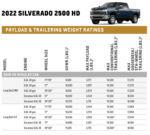The Ford Ranger is one of the most popular pickup trucks on the road, known for its rugged dependability and versatility. If you own or are looking to buy a 1999 Ford Ranger, understanding its towing capabilities is key to getting the most out of your truck. This comprehensive guide will provide all the details on the 1999 Ford Ranger’s towing capacities to help you haul confidently and safely.
As an ASE certified master technician with over 15 years of experience working on Ford trucks, I have extensive knowledge about optimizing Rangers for towing. Through my automotive blog, I aim to educate Ranger owners so they can get the maximum utility from their vehicles.
Overview of the 1999 Ford Ranger
The 1999 Ford Ranger came in a few different configurations that impact towing capacity:
- Trims – XL and XLT
- Cab – Regular Cab and SuperCab
- Bed Length – 6′ and 7′
- Drive Type – 2WD and 4WD
- Transmission – 5-speed manual or automatic
Under the hood, the 1999 Ranger offered three engine options:
- 2.5L I4 (119 hp, 146 lb-ft torque)
- 3.0L V6 (150 hp, 185 lb-ft torque)
- 4.0L V6 (160 hp, 225 lb-ft torque)
The stronger V6 engines deliver more horsepower and torque for increased towing muscle. Understanding the differences between the available powertrains is key to determining realistic towing capacities.
1999 Ford Ranger Maximum Towing Capacity
The maximum towing capacity for a properly equipped 1999 Ford Ranger is 6,000 lbs according to Ford’s towing guides. This top rating applies to 4WD regular cab models with the 4.0L V6 engine and 3.73 axle ratio.
However, towing capacities can vary significantly based on your Ranger’s configuration:
- 2.5L I4 – 1,440 to 2,240 lbs
- 3.0L V6 – 2,240 to 4,200 lbs
- 4.0L V6 – 5,660 to 6,000 lbs
As you can see, opting for one of the more powerful V6 engines opens up much greater towing potential compared to the base I4.
In addition, 4WD models offer higher tow ratings than 2WD, and regular cab versions can pull more than SuperCabs. Shorter 6′ beds are also better for towing than the heavier 7′ beds.
So a 4WD regular cab 4.0L V6 Ranger with a short bed has the highest capability, while a 2WD SuperCab XL with the 2.5L I4 has much lower capacities.
Towing Basics for 1999 Ford Rangers
When towing with your 1999 Ranger, there are some important rules of thumb to follow:
-
The gross combined weight of the truck and trailer should not exceed the GCWR listed in your owner’s manual. Exceeding this can overload the drivetrain.
-
The tongue weight of the loaded trailer should be between 10-15% of the total weight. Too little or too much tongue weight can affect stability.
-
With a weight distributing hitch, max towing capacity is 6,000 lbs. A step bumper is limited to 2,000 lbs.
-
For trailers over 5,000 lbs, use a weight distributing hitch. Under 5,000 lbs, a weight carrying hitch is sufficient.
-
Pay close attention to GVWR, GAWR, and GCWR ratings to avoid overloading axles or the vehicle.
-
Use extra caution when towing in hilly terrain – reduce speed and trailer weight as elevation increases.
Adhering to Ford’s towing guidelines will ensure safe, stable handling when towing with your Ranger. Never exceed the recommended capacities for your particular configuration.
Towing Capacity By Cab, Bed, and Drive Type
To give you a better idea of how cab, bed, and drivetrain impact the 1999 Ranger’s tow ratings, here are the detailed capacities:
2WD
- Regular Cab, 6′ Bed – 1,600 lbs (I4), 4,000 lbs (V6)
- Regular Cab, 7′ Bed – 1,600 lbs (I4), 4,000 lbs (V6)
- SuperCab, 6′ Bed – 1,440 lbs (I4), 4,000 lbs (V6)
4WD
- Regular Cab, 6′ Bed – 2,400 lbs (I4), 3,800-4,360 lbs (V6)
- Regular Cab, 7′ Bed – 2,400 lbs (I4), 3,800-4,360 lbs (V6)
- SuperCab, 6′ Bed – 2,240 lbs (I4), 3,700-4,200 lbs (V6)
As you can see, 4WD boosts capacities by about 800-1,200 lbs depending on powertrain. Regular cabs also gain about 400-600 lbs over SuperCabs.
The V6 engines unlock the possibility for over 4,000 lbs of towing, while the I4 remains limited to light duty towing.
Payload Capacities
In addition to towing limits, pay attention to payload – the combined weight of passengers and cargo – when using your Ranger for hauling.
Here are the payload ranges for 1999 Rangers:
- Regular Cab 2WD: 1,260-1,660 lbs
- Regular Cab 4WD: 1,260-1,540 lbs
- SuperCab 2WD: 1,260-1,620 lbs
- SuperCab 4WD: 1,260-1,520 lbs
Payload affects how much tongue weight your truck can handle, so larger payloads expand your towing flexibility.
I recommend tallying up passenger weights, cargo, hitch weight, and options to ensure you do not exceed GVWR or GAWR limits.
Towing Packages and Equipment
While the 1999 Ranger did not offer a dedicated towing package, several equipment upgrades are recommended:
-
Hitch receiver – Provides a standard 2″ x 2″ receiver for attaching ball mounts. Required for towing over 2,000 lbs.
-
Heavy duty flasher – Improves turn signal visibility when towing.
-
External transmission cooler – Prevents overheating of automatic transmissions under heavy loads.
-
Trailer brake controller – Activates electric or electric-over-hydraulic brakes on properly equipped trailers. Provides crucial extra stopping power.
-
Tow mirrors – Manual extendable mirrors that expand rearward visibility with a trailer in tow.
-
Upgraded rear suspension – Stiffer springs, shocks, and sway bars help control trailer sway.
While not essential, these upgrades improve the towing experience and are recommended for frequent hauling. Consult your Ford dealer for help selecting towing gear.
Weight Distribution and Sway Control
For maximum stability and control while towing heavy loads, a weight distributing hitch is strongly recommended. This type of hitch applies leverage to transfer tongue weight across both axles instead of letting it all rest on the rear suspension.
A sway control system is also advised for controlling trailer sway. This uses a dampening system to minimize lateral movement of the trailer.
Weight distribution combined with sway control provides optimal handling when towing near the Ranger’s maximum capacities.
Towing Tips and Safety
Here are some key towing safety tips:
-
Practice maneuvering, backing up, and connecting/disconnecting your trailer before hitting the road.
-
Adjust your side mirrors to eliminate blind spots. Consider extended mirrors for greater visibility.
-
Allow extra distance for braking when towing heavy loads.
-
Avoid using overdrive and always start out in lower gears when accelerating with a trailer.
-
Use lower than normal speeds when towing, especially on grades.
-
Periodically check wheel hubs on trailer for overheating.
Following Ford’s guidelines and practicing safe habits will allow you to get years of reliable service hauling with your 1999 Ranger. Understanding your vehicle’s capabilities is the first step to maximizing utility while staying safe.




